|
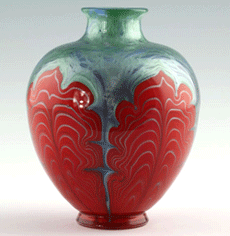 $7,900 (42 bids): Loetz Witwe Titania Gre 6388 Vase Art Glass 1909, Art Nouveau deco Lötz Bohemia. Museum-quality vase of the Bohemian glass manufactory Lötz Witwe from Klostermühle around 1909. Pattern: TITANIA Gre 6388 – blauopal and kaiserrot. Clear red and metallic blue glass, pontil mark on the bottom. Height: 18 cm. Very nice, undamaged condition. Literature reference with photo: Hemlmut Ricke: Lötz – Böhmisches Glas 1880-1940, New York 2003, page 315. (Photo, courtesy of eBay seller carsten-antik.) $7,900 (42 bids): Loetz Witwe Titania Gre 6388 Vase Art Glass 1909, Art Nouveau deco Lötz Bohemia. Museum-quality vase of the Bohemian glass manufactory Lötz Witwe from Klostermühle around 1909. Pattern: TITANIA Gre 6388 – blauopal and kaiserrot. Clear red and metallic blue glass, pontil mark on the bottom. Height: 18 cm. Very nice, undamaged condition. Literature reference with photo: Hemlmut Ricke: Lötz – Böhmisches Glas 1880-1940, New York 2003, page 315. (Photo, courtesy of eBay seller carsten-antik.)
DBA: The J Lotz Witwe glassworks is a Czech Republic company founded by glass cutter Johann Lotz (1778-1844). Cut and engraved glass was made by his firm which, at his death, was run by his wife for several years. In 1879, the firm was taken over by her grandson, Knight Maximilian Spaun, and under his leadership, it gained international acclaim with many exhibition awards. Several techniques were characteristic of the glass: combed and marquetry patterns, opalescent and metallic glossy surfaces.
This object sold on eBay is a particularly fine vase, indeed museum quality. The price appears to be in line with prices paid at other auctions, mostly the well-known international auctions. Small Loetz vases are found for sale by dealers, but this larger, multi-colored metallic glass is most commonly found at auction where the collectors bid against each other. What is more unusual is that this vase was sold on eBay and for a good, fair price without having to wait several months for the particular auction to begin. This was a good, fair exchange for buyer and seller.
* * * * * * * * * * * * * * * * *
$6,100 (20 bids): 4K Gold U.S. Customs Philadelphia Special Deputy Surveyor Badge 1899. United States Customs Badge from the Port of Philadelphia with “Special Deputy Surveyor” marked on bottom hanging bar. Reverse has the deputy's name and a date of 1899. Additionally, there is a circled number 14, indicating 14k gold. The back also has the badge pin and the catch. The total weight is 9.52 grams. The overall size is 1 5/8 inches x 1.25 inches. This is an original, 114-year-old, obsolete badge that far surpasses the quality of common, modern badges. The use of 14k gold and colored enamels along with the rich and sharp engraving is not something used in today’s badges. The front of the pin has an American eagle, a 13-star flag with seven bars and a smaller eagle with red, white and blue enameling. There is fine engraving on the areas around the center which stands out from the blue enameling. Overall, the badge is in excellent condition with no signs of any damage. There is very slight tarnishing and a very small area of dried polish on the reverse of the badge. The catch is bent slightly, not allowing the pin to close properly (easily repairable). The front of the pin is almost mint and is very bright. This is a very rare badge with no other examples discovered. This is an example of very fine American craftsmanship from the Late Victorian Period. The badge has not been cleaned and is in original condition. (Photo, courtesy of eBay seller greatgryphon.)
|
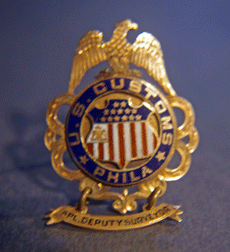
|
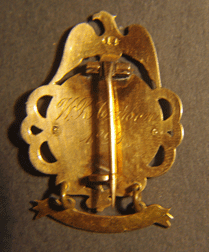
|
DBA: This listing surprises me, not because of the amount of money that was paid for it, as there is a large group of badge collectors, but because it was sold on eBay. EBay has a policy about selling official badges, and this one would have been allowed because it is over 100 years old. EBay is an international venue, and there are many companies operating outside of the United States that produce and sell fake badges. One can understand why fake police badges or other official-looking ID should not be sold. Customs officials’ badges are listed in that restricted category.
There has been a large badge collector group for a long time. However, this is likely to be an area of collecting for which we shall see more restrictions concerning selling. Does that make this type of collection more or less appealing?
* * * * * * * * * * * * * * * * *
$5,724 (32 bids): Loring Andrews Sterling Silver Castle & Manor House Vase, ca. 1890. An unusually rare form from the maker, the Loring Andrews Company, listed in the late 19th century. The firm crafted the finest silver, as well as retailing others, mostly Kirk. Given their playful designs and superb finish detail, their work is highly sought. Numerous examples in the Cincinnati Art Museum.
Classic, shapely baluster form; elegant satin-chased florette and cascading leaf rim and base. Beautifully hand-carved castle and English manor house scenes. Each castle display is distinct in design from the other, one with a cobblestone archway above a gentle stream. Tall spire and turrets, pavilion windows and entryway. All of this set high above the great walls. Followed by richly carved hummingbirds amidst lush florals. You can see one with a long slender beak sucking the nectar from its flower. Set against a rich satin background. Throughout, the piece displays the finest finish detail for which Loring was known. Finer than Kirk of the period. Never monogrammed. Hallmarked. This Loring Andrews castle and manor vase is 13 1/8 inches tall. Exceptionally thick, heavy gauge sterling weighs 32 (standard) ounces. Excellent condition, if not pristine. Rich, lustrous silver patina. The beautifully carved castle and manor displays retain their original crisp, vibrant, hand-chased detail. Stands perfectly firm on a table or display shelf. (Photo, courtesy of eBay seller supershrink.)
|
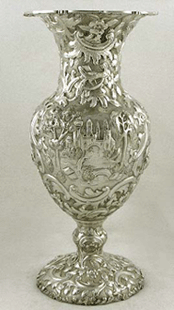
|
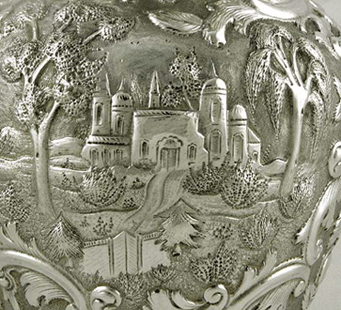
|
DBA: The latest research seems to indicate that Loring Andrews and Company was a retailer of silver, not the manufacturer. Loring Andrews, the person, was born in Cincinnati in 1854 and died there in 1921. He was listed as a salesman for Everett Isbell & Co. from 1887 to 1894 in city directories. Loring Andrews & Company first shows up in Cincinnati directories in 1896. It appears that most of the silver was manufactured by Kirk or other Baltimore silversmiths. The “Castle” pattern was not exclusive to the Loring Andrews Co. There are several silver companies who produced that pattern, including Kirk. It can be found in coin and sterling silver.
One almost identical to this vase was sold at Bonham’s N.Y. on 24 January 2013 for $2,750 including the buyer’s premium. That would have definitely been a good buy! The eBay price of $5724 is closer to a retail price for the object.
* * * * * * * * * * * * * * * * *
$4,706 (33 bids) Occupational Mug, Erie Railroad, Spring Valley, NY, Station Agent's Mug, ca. 1900. Unique, since we know the actual man that owned this mug. Image on front depicts a train depot with the words “Spring Valley” written on the building signage. The name written across the top in black and gold script is “D.W. Smith Agt.” Bottom of mug marked, “J & C Bavaria,”—this mark was used between 1898 and 1923. D.W. Smith worked as a Station Agent for the Erie Railroad for 57 years. Looks like he started work for the railroad in 1889. This piece has no chips, no cracks and no breaks and no hairlines. The gold loss around the rim and a little on the handle is all that is wrong with it. The pink coloring, which can be seen in the photos, is mottled, and I am assuming that this is due to manufacturing process. Measurements: 3.75 inches high; top diameter, 3 5/8 inches; bottom diameter 3.5 inches. (Photo, courtesy of eBay seller pemigewasset361, www.citycountrygallery.com.)
|
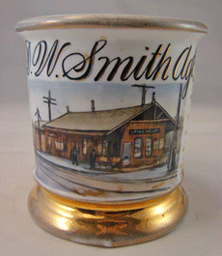
|
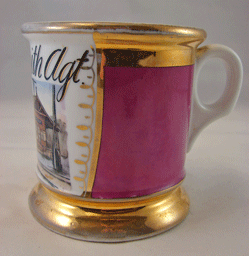
|
DBA: This is actually a shaving mug. Whether a man shaved at home or at the local barbershop, most men owned their own shaving mug. It was thought to reduce the rashes caught, but actually it was the unsanitary blades that caused the rash, not the soap, brush or container. It was a status symbol for the individual man and for the barbershop to show its clientele. The blanks were imported from Germany or France and were hand-painted with basic designs or very elaborate designs. Some mugs even have gold leaf and ceramic glazes. Not all were occupations as hobbies can be found on some shaving mugs. A fairly recent auction of antique shaving mugs showed prices at auction of a low of $23 to the highest one at $9,487.50. This particular shaving mug could be considered a railroad collectible as well.
This mug is at a middle price point, but it is still quite pricey. As to future prices for this type of collectible, shaving mugs have a longer history than Beanie Babies, but who knows? This is definitely a “men’s collectible,” and with the advent of “the man cave” in almost every home, there is quite possibly a monetary return on such an investment.
Deborah Abernethy is a certified appraiser with the International Association of Appraisers. She can be contacted at 404-262-2131 or Deborah@expert-appraisers.com
. Her website is www.expert-appraisers.com
.
|